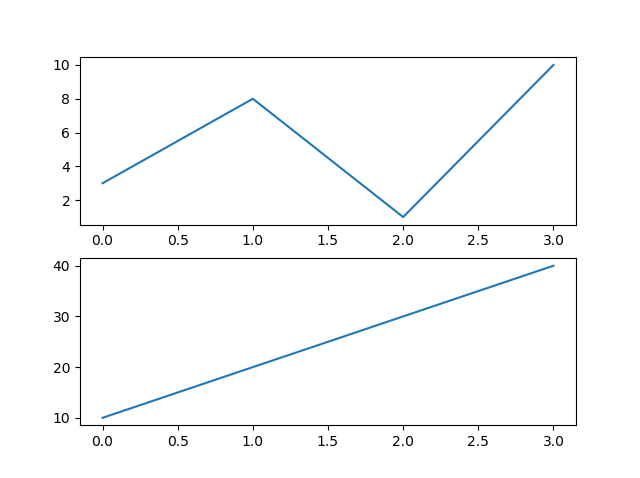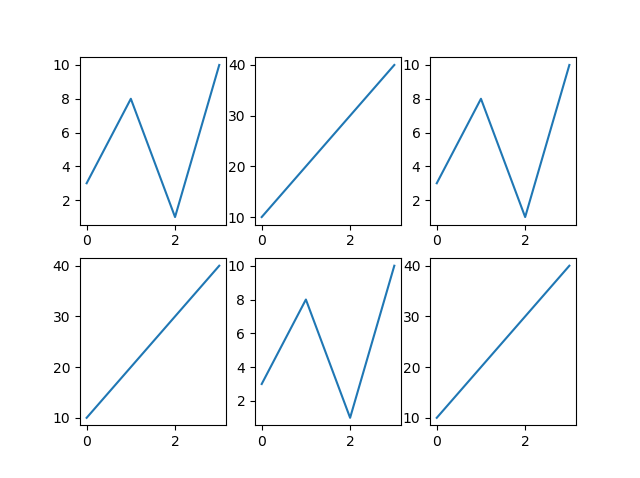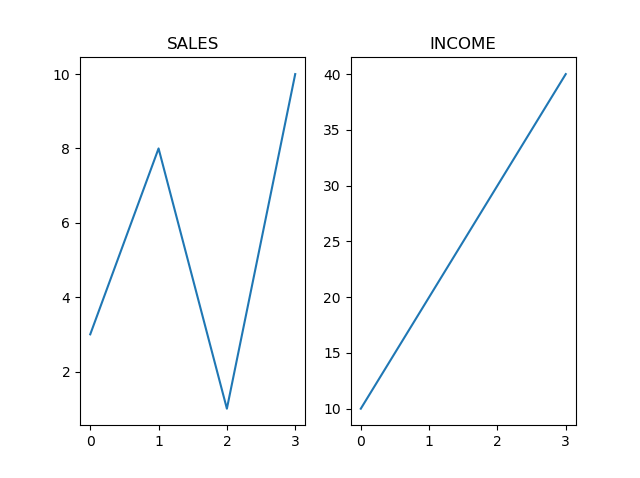Matplotlib еӯҗеӣҫ
жҳҫзӨәеӨҡдёӘеӣҫиЎЁ
йҖҡиҝҮ subplot() еҮҪж•°пјҢжӮЁеҸҜд»ҘеңЁдёҖдёӘеӣҫеҪўдёӯз»ҳеҲ¶еӨҡдёӘеӣҫиЎЁпјҡ
е®һдҫӢ
з»ҳеҲ¶ 2 дёӘеӣҫиЎЁпјҡ
import matplotlib.pyplot as plt import numpy as np # еӣҫиЎЁ 1пјҡ x = np.array([0, 1, 2, 3]) y = np.array([3, 8, 1, 10]) plt.subplot(1, 2, 1) plt.plot(x,y) # еӣҫиЎЁ 2пјҡ x = np.array([0, 1, 2, 3]) y = np.array([10, 20, 30, 40]) plt.subplot(1, 2, 2) plt.plot(x,y) plt.show()
з»“жһңпјҡ

subplot() еҮҪж•°
subplot() еҮҪж•°жҺҘеҸ—дёүдёӘеҸӮж•°пјҢиҝҷдәӣеҸӮж•°жҸҸиҝ°дәҶеӣҫеҪўзҡ„еёғеұҖгҖӮ
еёғеұҖд»ҘиЎҢе’ҢеҲ—з»„з»ҮпјҢеҲҶеҲ«з”ұ第дёҖдёӘе’Ң第дәҢдёӘеҸӮж•°иЎЁзӨәгҖӮ
第дёүдёӘеҸӮж•°иЎЁзӨәеҪ“еүҚеӣҫиЎЁзҡ„зҙўеј•гҖӮ
plt.subplot(1, 2, 1) # еӣҫеҪўжңү 1 иЎҢпјҢ2 еҲ—пјҢиҝҷдёӘеӣҫиЎЁжҳҜ第дёҖдёӘеӣҫиЎЁгҖӮ
plt.subplot(1, 2, 2) # еӣҫеҪўжңү 1 иЎҢпјҢ2 еҲ—пјҢиҝҷдёӘеӣҫиЎЁжҳҜ第дәҢдёӘеӣҫиЎЁгҖӮ
еӣ жӯӨпјҢеҰӮжһңжҲ‘们жғіиҰҒдёҖдёӘе…·жңү 2 иЎҢ 1 еҲ—зҡ„еӣҫеҪўпјҲж„Ҹе‘ізқҖдёӨдёӘеӣҫиЎЁе°ҶдёҠдёӢжҳҫзӨәиҖҢдёҚжҳҜ并жҺ’жҳҫзӨәпјүпјҢжҲ‘们еҸҜд»Ҙиҝҷж ·еҶҷиҜӯжі•пјҡ
е®һдҫӢ
дёҠдёӢжҳҫзӨә 2 дёӘеӣҫиЎЁпјҡ
import matplotlib.pyplot as plt import numpy as np # еӣҫиЎЁ 1пјҡ x = np.array([0, 1, 2, 3]) y = np.array([3, 8, 1, 10]) plt.subplot(2, 1, 1) plt.plot(x,y) # еӣҫиЎЁ 2пјҡ x = np.array([0, 1, 2, 3]) y = np.array([10, 20, 30, 40]) plt.subplot(2, 1, 2) plt.plot(x,y) plt.show()
з»“жһңпјҡ

жӮЁеҸҜд»ҘеңЁдёҖдёӘеӣҫеҪўдёҠз»ҳеҲ¶д»»ж„Ҹж•°йҮҸзҡ„еӣҫиЎЁпјҢеҸӘйңҖжҸҸиҝ°иЎҢж•°гҖҒеҲ—ж•°е’ҢеӣҫиЎЁзҡ„зҙўеј•еҚіеҸҜгҖӮ
е®һдҫӢ
Draw 6 plots:
import matplotlib.pyplot as plt import numpy as np x = np.array([0, 1, 2, 3]) y = np.array([3, 8, 1, 10]) plt.subplot(2, 3, 1) plt.plot(x,y) x = np.array([0, 1, 2, 3]) y = np.array([10, 20, 30, 40]) plt.subplot(2, 3, 2) plt.plot(x,y) x = np.array([0, 1, 2, 3]) y = np.array([3, 8, 1, 10]) plt.subplot(2, 3, 3) plt.plot(x,y) x = np.array([0, 1, 2, 3]) y = np.array([10, 20, 30, 40]) plt.subplot(2, 3, 4) plt.plot(x,y) x = np.array([0, 1, 2, 3]) y = np.array([3, 8, 1, 10]) plt.subplot(2, 3, 5) plt.plot(x,y) x = np.array([0, 1, 2, 3]) y = np.array([10, 20, 30, 40]) plt.subplot(2, 3, 6) plt.plot(x,y) plt.show()
з»“жһңпјҡ

ж Үйўҳ
жӮЁеҸҜд»ҘдҪҝз”Ё title() еҮҪж•°дёәжҜҸдёӘеӣҫиЎЁж·»еҠ ж Үйўҳпјҡ
е®һдҫӢ
2 plots, with titles:
import matplotlib.pyplot as plt
import numpy as np
# еӣҫиЎЁ 1пјҡ
x = np.array([0, 1, 2, 3])
y = np.array([3, 8, 1, 10])
plt.subplot(1, 2, 1)
plt.plot(x,y)
plt.title("й”Җе”®")
# еӣҫиЎЁ 2пјҡ
x = np.array([0, 1, 2, 3])
y = np.array([10, 20, 30, 40])
plt.subplot(1, 2, 2)
plt.plot(x,y)
plt.title("收е…Ҙ")
plt.show()
з»“жһңпјҡ

жҖ»ж Үйўҳ
жӮЁеҸҜд»ҘдҪҝз”Ё suptitle() еҮҪж•°дёәж•ҙдёӘеӣҫеҪўж·»еҠ ж Үйўҳпјҡ
е®һдҫӢ
дёәж•ҙдёӘеӣҫеҪўж·»еҠ ж Үйўҳпјҡ
import matplotlib.pyplot as plt
import numpy as np
# еӣҫиЎЁ 1пјҡ
x = np.array([0, 1, 2, 3])
y = np.array([3, 8, 1, 10])
plt.subplot(1, 2, 1)
plt.plot(x,y)
plt.title("й”Җе”®")
# еӣҫиЎЁ 2пјҡ
x = np.array([0, 1, 2, 3])
y = np.array([10, 20, 30, 40])
plt.subplot(1, 2, 2)
plt.plot(x,y)
plt.title("收е…Ҙ")
plt.suptitle("жҲ‘зҡ„е•Ҷеә—")
plt.show()
з»“жһңпјҡ
